Click On Image
For Full Size Image |
Size |
Image Description |
Contributed
By |
Namesake
|
 |
68k | Charles Wilkes was born on 3 April 1798 in New York City. He served in merchant ships between 1815 and 1817 before being appointed a midshipman in the United States Navy on New Year's Day 1818. Following initial training in Independence, he transferred to Guerriere in July 1818 for a cruise in the Baltic and Mediterranean Seas. After a two-month assignment in Washington between March and May 1821, Midshipman Wilkes received orders to Franklin, in which ship he voyaged to South America. During that cruise, Wilkes briefly commanded Franklin's tender Waterwitch before being detached from Franklin on 3 March 1823 to command the American merchant ship Ocain on her way back to Boston, where he arrived on 15 October. From there, he reported to Washington for duty in conjunction with the court-martial of Captain Stewart, his former commanding officer in Franklin. On 28 April 1827, Wilkes was promoted to lieutenant. Apparently at home awaiting orders between 1826 and 1830, Lt. Wilkes requested surveying duty in March of 1827 but withdrew his application in July 1828 in favor of one for duty with a proposed exploring expedition. Late that fall, he received orders to New York where he set about the task of procuring the necessary instruments for that expedition. In April 1830, Lt. Wilkes resumed sea duty. Assigned to Boston, he made a cruise in her to the Mediterranean. On 15 November, he transferred to Fairfield in which ship he served until May 1831 at which time he was detached and ordered home to await orders. Late in the spring of 1832, Wilkes returned to active duty as a member of the team which surveyed Narragansett Bay. In February 1833, he received orders to duty in charge of the Depot of Charts and Instruments (forerunner of both the Naval Oceanographic Office and of the Naval Observatory). In August of 1836, Wilkes briefly took leave of that post when he sailed to Europe to acquire additional equipment for the exploring expedition. He returned to the Depot of Charts and Instruments after that trip; and, in March 1837, Secretary of the Navy Mahlon Dickerson requested Wilkes to take a position in the astronomy department of the exploring expedition. That fall, he participated in an oceanographic survey of the Carolina coast. The following spring, Wilkes learned that he had been chosen to command the South Seas Exploring Expedition. President Van Buren approved his appointment on 20 April, and Wilkes assumed command of Vincennes at Norfolk on 7 July. He received his final orders on 11 August and set sail in Vincennes in company with Peacock, Porpoise, Sea Gull, Flying Fish, and Relief on the 18th. After stops at Rio de Janeiro, Brazil, and Tierra del Fuego at the southern tip of South America, Wilkes took his expedition on its first cruise through Antarctic waters in February and March of 1839. He returned to Tierra del Fuego and then later headed through the South Seas to Sydney, Australia, where he arrived on 29 November. On the day after Christmas, he embarked upon his second voyage to the Antarctic. In January 1840, he sighted the actual land mass which constitutes Antarctica, though it took later explorations to vindicate his assertions that the continent existed. By late spring 1840, the expedition moved north again and began the exploration of the islands of the South Pacific. After surveying the Fiji Islands between May and August, the expedition departed those islands, bound for Hawaii on 11 August. The Hawaiian survey, conducted between 24 September 1840 and 5 April 1841, centered upon a study of the volcanoes Mauna Loa and Kilauea. Wilkes completed his work in Hawaii in April 1841 and set sail on the 5th for the west coast. After surveys of parts of the coast of the Pacific Northwest during the summer of 1841, he brought his expedition into San Francisco on 14 August. Its arrival back in the United States, however, signaled no end to the work of the expedition. On 1 November, it put to sea once again, this time for a voyage to the western Pacific. During that cruise, Wilkes visited Manila in the Philippines, the British colony at Singapore, and Cape Town on the southern tip of Africa. Wilkes and his command concluded the expedition upon arrival at New York on 10 June 1842. For almost 19 years, Wilkes worked with the data gathered by his expedition. During that period, he supervised the publication of the results of that exploration in a series of Narratives under the auspices of the Navy. He also received two promotions during that time to commander in 1843 and to captain in 1855. The only break in this duty came in the second half of 1858 when the Secretary of the Navy sent Wilkes on a special mission to evaluate the potential for naval use of the natural resources primarily iron, coal, and timber of North Carolina's Deep River region. The outbreak of the Civil War, however, brought an interruption to his scientific work. On 19 April, he was detached from his duty with the expedition publication program in order to help destroy the Norfolk Navy Yard before Union forces abandoned it to the Confederacy. In May, Captain Wilkes received orders to take command of the steam-powered frigate San Jacinto. He arrived on board his new command on 27 August, at Monrovia, Liberia, just before she set sail to return to the United States. During the voyage home, he took her to the West Indies in search of the Southern commerce raider, CSS Sumter, under the command of Captain Raphael Semmes. During that mission, his ship stopped at Cienfuegos, Cuba, for coal, and Wilkes learned that the Confederate commissioners to England and France, James Mason and John Slidell, had escaped from Charleston on board the fast coastal packet Theodora and were then in Havana awaiting transportation to Europe. San Jacinto quickly headed for Havana, hoping to catch Theodora when she embarked upon her return trip, but arrived a day late. He learned, however, that Mason and Slidell were still in Cuba and planned to board the British mail packet Trent at St. Thomas for the voyage to Europe. Thereupon, he concocted a plan to intercept Trent in Old Bahama Channel, some 230 miles east of Havana, and capture the two Confederate diplomats. On 8 November, the British ship steamed into sight, and Wilkes coerced her into stopping with two shots across her bow. A boarding party seized Mason and Slidell and their secretaries and then allowed the neutral ship to continue her voyage. San Jacinto then headed home with her prisoners. Upon his arrival in Boston, Wilkes was loudly acclaimed for his action, but soon the clouds of war with Great Britain over the incident began to darken the horizon. Ultimately, the dubious legality of Wilkes' action and the threat of war with Britain and France brought a complete disavowal of Wilkes' act by the Federal Government and the release of the prisoners. On 30 November, Captain Wilkes was detached from San Jacinto and ordered to duty with the Board of Naval Examiners. That assignment lasted until the following summer. He commanded the James River Flotilla briefly in July and August of 1862 and received his promotion to commodore at that time. On 29 August, Wilkes left that post and took over the Potomac River Flotilla. That assignment proved to be of short duration. On 8 September, he received orders to command the West India Squadron. Promoted to acting rear admiral, Wilkes directed the Squadron-primarily concerned with hunting down Southern commerce raiders and blockade runners-until the summer of 1863. On 1 June, he was detached from the squadron and, on the 30th, set sail from Havana for the United States in Roanoke. Conflicts with the Navy Department, probably stemming from his treatment during the Trent affair negotiations, culminated in Wilkes' court-martial early in 1864 over the publication of a letter he wrote to Gideon Welles castigating the Secretary for statements made against Wilkes in his annual report. On 26 April 1864, Acting Rear Admiral Wilkes was found guilty by court-martial of disobedience of orders, insubordination, and other specifications and was sentenced to receive a public reprimand and suspension from the service for three years. President Lincoln reduced the term of suspension to one year, at the conclusion of which Wilkes retired from the Navy. On 6 August 1866, he was promoted to rear admiral on the retired list and, for the remainder of his life, worked for the completion of publication of the results of the Wilkes Exploring Expedition. He also took time out to do some writing, including an autobiography. On 8 February 1877, Rear Admiral Wilkes died at Washington, D.C. Initially interred at Oak Hill Cemetery in Washington, his body was moved to Arlington National Cemetery in August 1909. | Bill Gonyo |
USS Wilkes (DD-441)
|

| 251k | Undated, engineers looking at ship's battle ribbons. From the collection of William J. Mosher located at the National Destroyermens Museum housed aboard the USS Joseph P. Kennedy, Jr. (DD-850). | Ed Zajkowski |

| 223k | Undated, refueling from the USS Housatonic (AO-35) From the collection of William J. Mosher located at the National Destroyermens Museum housed aboard the USS Joseph P. Kennedy, Jr. (DD-850). | Ed Zajkowski |

| 107k | Undated, location unknown. | Robert Hurst |

| 139k | Moored at Boston Navy Yard, 01 July 1941. Navy Yard Boston photo 1572-41 | Mike Green |


Two views of Wilkes taken on 28 July 1941 at Boston Navy Yard as she completed fitting out. She was completed with the King Board Air Defense Improvements, with one 5-in mount removed and twelve 50-cal MGs being added. She has been painted in Ms 1 camouflage of Dark Gray 5-D and Light Gray 5-L tops. Note that she has the early application of her hull number on her hull below the bridge as was done during WWI.
Naval History and Heritage Command photo NH 50245 and Boston Navy Yard photo 1852-41. | Robert Hurst / Rick E. Davis |



Iced up off Iceland while on convoy duty November 1941. From the collection of William J. Mosher located at the National Destroyermens Museum housed aboard the USS Joseph P. Kennedy, Jr. (DD-850). | Ed Zajkowski |
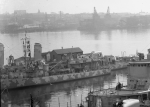 |
255k | USS Wilkes (DD-441) and PC-471 are seen moored to Pier 8 at Boston Navy Yard on 1 January 1942. PC-471 was the first operational PC having arrived at Boston from her builder Defoe Shipbuilding, Bay City, MI on 28 November 1941. PC-471 and her next two sisters, PC-472 and PC-473, would be the only units built at Defoe to depart from the builder to Boston Navy Yard via the St. Lawrence Seaway. Wilkes arrived at Boston shortly before Christmas for “Voyage Repairs” and installation of her SC radar. After drydocking WILKES moored as seen at Pier 8 on 30 December 1941. Both ships would depart Pier 8 at 1515 on 1 January, with Wilkes departing Boston for Casco Bay and PC-471 moving to moor directly to Pier 8 and then on 2 January she moved alongside her recently arrived sisters PC-472 and PC-473 at Pier 4 before heading on shakedown at 1559 on 2 January 1942. Note that both ships are painted in what is known as the “Jigsaw” Ms 12R(mod) camouflage pattern. Humboldt (AVP-21) is fitting out in the foreground.
National Archives photo 19-N-30362 |
Rick E. Davis |

| 218k | Early in 1942 in camouflage. From the collection of William J. Mosher located at the National Destroyermens Museum housed aboard the USS Joseph P. Kennedy, Jr. (DD-850). | Ed Zajkowski |

| 248k | View from the Wilkes looking at the USS Ludlow (DD-438), summer 1942. From the collection of William J. Mosher located at the National Destroyermens Museum housed aboard the USS Joseph P. Kennedy, Jr. (DD-850). | Ed Zajkowski |

| 132k | Wilkes about September 1942 prior to Operation Torch, likely off Boston Navy Yard. She still has six 20-mm guns and has been repainted into Ms 22. In December 1942 she had twin 40-mm mounts installed. | Ed Zajkowski / Rick E. Davis |

| 217k | November 1942, off Casablanca, shell splashes from Jean Bart. USS Augusta in background making smoke. From the collection of William J. Mosher located at the National Destroyermens Museum housed aboard the USS Joseph P. Kennedy, Jr. (DD-850). | Ed Zajkowski |

| 247k | November 1942, engineroom gang sleeping on deck plates after 48 hrs of continuous action. From the collection of William J. Mosher located at the National Destroyermens Museum housed aboard the USS Joseph P. Kennedy, Jr. (DD-850). | Ed Zajkowski |

| 152k | April 1943, Chesapeake Bay, practice firing a torpedo. From the collection of William J. Mosher located at the National Destroyermens Museum housed aboard the USS Joseph P. Kennedy, Jr. (DD-850). | Ed Zajkowski |

| 217k | Viewed from blimp ZNP-K-10, 02 May 1943. Photo by ENS W. Bjerie. | Ed Zajkowski |

| 182k | View of Wilkes on the Virginia coast, 02 May 1943. Wilkes was underway from Lynnhaven Roads for gunnery exercises, returning to Hampton Roads that evening. National Archives photo 80-G-68100. | John Chiquoine |

| 192k | At Mers-el-Kébir, Algeria, 20-24 June 1943. Photo taken from the Wilkes, with USS Swanson (DD-443) alongside, in the background is the USS Bristol (DD-453) outboard, and USS Ludlow (DD-438) inboard. The destroyers are moored alongside British repair ship HMS Vindictive. Vindictive was a Hawkins class cruiser converted to an aircraft carrier in 1918. After World War I, she was converted back to a cruiser, then became a training ship 1936-37. When World War II began, she was converted to a repair ship.
From the collection of William J. Mosher located at the National Destroyermens Museum housed aboard the USS Joseph P. Kennedy, Jr. (DD-850). | Ed Zajkowski |

| 217k | June 1943, Mers-el-Kébir, view from the Wilkes looking at the British HMS King George VI. From the collection of William J. Mosher located at the National Destroyermens Museum housed aboard the USS Joseph P. Kennedy, Jr. (DD-850). | Ed Zajkowski |

| 197k | August 1943, Wilkes' officers on the foc'sle at Brooklyn NY. From the collection of William J. Mosher located at the National Destroyermens Museum housed aboard the USS Joseph P. Kennedy, Jr. (DD-850). | Ed Zajkowski |



April 1944, Lt. General Walter Krueger, Sixth Army commander, used Wilkes to observe landings at New Britain, Admiralty Islands, etc. From the collection of William J. Mosher located at the National Destroyermens Museum housed aboard the USS Joseph P. Kennedy, Jr. (DD-850). | Ed Zajkowski |

| 135k | 20's and 40's firing at shore off New Guinea. From the collection of William J. Mosher located at the National Destroyermens Museum housed aboard the USS Joseph P. Kennedy, Jr. (DD-850). | Ed Zajkowski |

| 131k | Escorting USS New Mexico (BB-40) and firing 20's at towed target sleeve. From the collection of William J. Mosher located at the National Destroyermens Museum housed aboard the USS Joseph P. Kennedy, Jr. (DD-850). | Ed Zajkowski |

| 97k | Captain Fred Wolsieffer (44-45) on fantail by depth charges. From the collection of William J. Mosher located at the National Destroyermens Museum housed aboard the USS Joseph P. Kennedy, Jr. (DD-850). | Ed Zajkowski |

| 80k | Captain Fred Wolsieffer (44-45) on the Bridge. From the collection of William J. Mosher located at the National Destroyermens Museum housed aboard the USS Joseph P. Kennedy, Jr. (DD-850). | Ed Zajkowski |
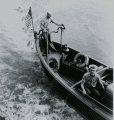
| 123k | April 44 at Buna, the whaleboat pulling swimmers. From the collection of William J. Mosher located at the National Destroyermens Museum housed aboard the USS Joseph P. Kennedy, Jr. (DD-850). | Ed Zajkowski |

| 87k | April 44 at Buna, signalman talking with USS Dobbin (AD-3). From the collection of William J. Mosher located at the National Destroyermens Museum housed aboard the USS Joseph P. Kennedy, Jr. (DD-850). | Ed Zajkowski |

| 131k | April 44, Mount 52 showing burned paint after shelling the Admiralty Islands. From the collection of William J. Mosher located at the National Destroyermens Museum housed aboard the USS Joseph P. Kennedy, Jr. (DD-850). | Ed Zajkowski |

| 142k | As above. From the collection of William J. Mosher located at the National Destroyermens Museum housed aboard the USS Joseph P. Kennedy, Jr. (DD-850). | Ed Zajkowski |

| 226k | The shellback ceremony, April 1944. From the collection of William J. Mosher located at the National Destroyermens Museum housed aboard the USS Joseph P. Kennedy, Jr. (DD-850). | Ed Zajkowski |

| 183k | As above. From the collection of William J. Mosher located at the National Destroyermens Museum housed aboard the USS Joseph P. Kennedy, Jr. (DD-850). | Ed Zajkowski |

| 79k | Watching flight ops on the "Big E," USS Enterprise part of TG38.4 during September 1944. From the collection of William J. Mosher located at the National Destroyermens Museum housed aboard the USS Joseph P. Kennedy, Jr. (DD-850). | Ed Zajkowski |

| 155k | Hi-lining wounded and downed pilots to a carrier. From the collection of William J. Mosher located at the National Destroyermens Museum housed aboard the USS Joseph P. Kennedy, Jr. (DD-850). | Ed Zajkowski |

| 257k | Refueling at sea as seen from amidships. From the collection of William J. Mosher located at the National Destroyermens Museum housed aboard the USS Joseph P. Kennedy, Jr. (DD-850). | Ed Zajkowski |

| 150k | Seeadler Harbor. From the collection of William J. Mosher located at the National Destroyermens Museum housed aboard the USS Joseph P. Kennedy, Jr. (DD-850). | Ed Zajkowski |

| 131k | A lookout standing watch. From the collection of William J. Mosher located at the National Destroyermens Museum housed aboard the USS Joseph P. Kennedy, Jr. (DD-850). | Ed Zajkowski |

| 125k | Loading supplies via hi-line. From the collection of William J. Mosher located at the National Destroyermens Museum housed aboard the USS Joseph P. Kennedy, Jr. (DD-850). | Ed Zajkowski |
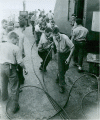
| 159k | Hi-line with line handlers aft. From the collection of William J. Mosher located at the National Destroyermens Museum housed aboard the USS Joseph P. Kennedy, Jr. (DD-850). | Ed Zajkowski |

| 96k | The XO, Dick Weiss. From the collection of William J. Mosher located at the National Destroyermens Museum housed aboard the USS Joseph P. Kennedy, Jr. (DD-850). | Ed Zajkowski |

| 84k | The Ship's Doctor, B. Stollman. From the collection of William J. Mosher located at the National Destroyermens Museum housed aboard the USS Joseph P. Kennedy, Jr. (DD-850). | Ed Zajkowski |

| 93k | The Supply Officer, Simmons, on the bridge. From the collection of William J. Mosher located at the National Destroyermens Museum housed aboard the USS Joseph P. Kennedy, Jr. (DD-850). | Ed Zajkowski |

| 129k | Off Okinawa, USS Swanson and 2 DE's in the distance. From the collection of William J. Mosher located at the National Destroyermens Museum housed aboard the USS Joseph P. Kennedy, Jr. (DD-850). | Ed Zajkowski |

| 153k | 14 August 1944, Fred Wolsieffer reads his orders detaching him as CO. From the collection of William J. Mosher located at the National Destroyermens Museum housed aboard the USS Joseph P. Kennedy, Jr. (DD-850). | Ed Zajkowski |

| 158k | 14 August 1944, Fred McEntyre salutes and takes command. From the collection of William J. Mosher located at the National Destroyermens Museum housed aboard the USS Joseph P. Kennedy, Jr. (DD-850). | Ed Zajkowski |
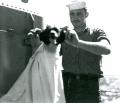
| 78k | 1945, Ship's Barber cutting mascot's hair, dogs name was Gyro. From the collection of William J. Mosher located at the National Destroyermens Museum housed aboard the USS Joseph P. Kennedy, Jr. (DD-850). | Ed Zajkowski |

| 150k | 1945, "S" Division . From the collection of William J. Mosher located at the National Destroyermens Museum housed aboard the USS Joseph P. Kennedy, Jr. (DD-850). | Ed Zajkowski |

| 121k | 1945, Deck Division . From the collection of William J. Mosher located at the National Destroyermens Museum housed aboard the USS Joseph P. Kennedy, Jr. (DD-850). | Ed Zajkowski |

| 210k | 1945, the Engineering Department. From the collection of William J. Mosher located at the National Destroyermens Museum housed aboard the USS Joseph P. Kennedy, Jr. (DD-850). | Ed Zajkowski |

| 167k | Top - Combat Information Center., bottom is the Torpedo Gang. From the collection of William J. Mosher located at the National Destroyermens Museum housed aboard the USS Joseph P. Kennedy, Jr. (DD-850). | Ed Zajkowski |

| 203k | Happy Hour with Captain McEntyre in the center. From the collection of William J. Mosher located at the National Destroyermens Museum housed aboard the USS Joseph P. Kennedy, Jr. (DD-850). | Ed Zajkowski |

| 197k | April 22 1945, 12 plankowners, 4 years. From the collection of William J. Mosher located at the National Destroyermens Museum housed aboard the USS Joseph P. Kennedy, Jr. (DD-850). | Ed Zajkowski |




May 4 1945, Wilkes rescues PBM crew, plane ran out of fuel, and towed plane to harbor. From the collection of William J. Mosher located at the National Destroyermens Museum housed aboard the USS Joseph P. Kennedy, Jr. (DD-850). | Ed Zajkowski |

| 857k | Wilkes as seen from USS Sargent Bay (CVE-83), 08 June 1945. Wilkes was operating with Task Unit 32.1.1, screening carriers during the invasion of Okinawa, and refuled from the CVE this date.National Archives photo 80-G-264151 | - |

| 165k | CDR Fred McIntyre departing as CO and LCDR Herbert Rommel takes over as CO. From the collection of William J. Mosher located at the National Destroyermens Museum housed aboard the USS Joseph P. Kennedy, Jr. (DD-850). | Ed Zajkowski |

| 123k | Off the coast of Korea in September 1945. From the collection of William J. Mosher located at the National Destroyermens Museum housed aboard the USS Joseph P. Kennedy, Jr. (DD-850). | Ed Zajkowski |

| 188k | September 1945 at Ito Island, Korea. #1 is unknown, #2 is Captain Rommel and #3 is the XO Raworth. From the collection of William J. Mosher located at the National Destroyermens Museum housed aboard the USS Joseph P. Kennedy, Jr. (DD-850). | Ed Zajkowski |

| 168k | September 1945, on the left are the CPO's and on the right is the Bridge Gang. From the collection of William J. Mosher located at the National Destroyermens Museum housed aboard the USS Joseph P. Kennedy, Jr. (DD-850). | Ed Zajkowski |

| 185k | September 1945, the Cooks, Bakers and Stewards. From the collection of William J. Mosher located at the National Destroyermens Museum housed aboard the USS Joseph P. Kennedy, Jr. (DD-850). | Ed Zajkowski |

| 209k | September 1945, top is First Division, middle is Second Division and bottom is C Division. From the collection of William J. Mosher located at the National Destroyermens Museum housed aboard the USS Joseph P. Kennedy, Jr. (DD-850). | Ed Zajkowski |

| 126k | September 1945, training on the 20mm, torpedo tubes and the 40mm guns. From the collection of William J. Mosher located at the National Destroyermens Museum housed aboard the USS Joseph P. Kennedy, Jr. (DD-850). | Ed Zajkowski |

| 107k | September 1945, Commodore Brodie presents the Ship's Mascot "Gyro" to Chief Leslie at end of war. From the collection of William J. Mosher located at the National Destroyermens Museum housed aboard the USS Joseph P. Kennedy, Jr. (DD-850). | Ed Zajkowski |

| 100k | September 1945, USS Guam (CB-2) and a Korean Junk as seen from the Wilkes. From the collection of William J. Mosher located at the National Destroyermens Museum housed aboard the USS Joseph P. Kennedy, Jr. (DD-850). | Ed Zajkowski |

| 71k | September 1945, LT Walt ringing ships bell on VJ Day. From the collection of William J. Mosher located at the National Destroyermens Museum housed aboard the USS Joseph P. Kennedy, Jr. (DD-850). | Ed Zajkowski |

| 200k | September 1945, ships officers in the wardroom, Captain Rommel at the head of the table. From the collection of William J. Mosher located at the National Destroyermens Museum housed aboard the USS Joseph P. Kennedy, Jr. (DD-850). | Ed Zajkowski |

| 124k | September 1945, David Johnson, Assistant Engineering Officer and ship's photographer. From the collection of William J. Mosher located at the National Destroyermens Museum housed aboard the USS Joseph P. Kennedy, Jr. (DD-850). | Ed Zajkowski |

| 204k | September 1945, Lowering the whaleboat. From the collection of William J. Mosher located at the National Destroyermens Museum housed aboard the USS Joseph P. Kennedy, Jr. (DD-850). | Ed Zajkowski |

| 92k | September 1945, Gyro, the ship's mascot. From the collection of William J. Mosher located at the National Destroyermens Museum housed aboard the USS Joseph P. Kennedy, Jr. (DD-850). | Ed Zajkowski |

| 101k | September 1945, Commodore Brodie and his DesDiv 14 staff. From the collection of William J. Mosher located at the National Destroyermens Museum housed aboard the USS Joseph P. Kennedy, Jr. (DD-850). | Ed Zajkowski |

| 88k | September 1945, the torpedo director. From the collection of William J. Mosher located at the National Destroyermens Museum housed aboard the USS Joseph P. Kennedy, Jr. (DD-850). | Ed Zajkowski |

| 122k | October 1945, gunnery practice. From the collection of William J. Mosher located at the National Destroyermens Museum housed aboard the USS Joseph P. Kennedy, Jr. (DD-850). | Ed Zajkowski |

| 207k | October 1945, Engineering Deptartment Officers and CPO's. From the collection of William J. Mosher located at the National Destroyermens Museum housed aboard the USS Joseph P. Kennedy, Jr. (DD-850). | Ed Zajkowski |

| 172k | October 1945, Captain Rommel and RM2/c Donald Stump. From the collection of William J. Mosher located at the National Destroyermens Museum housed aboard the USS Joseph P. Kennedy, Jr. (DD-850). | Ed Zajkowski |

| 134k | November 1945, a page from Bill's album showing the journey home with the Swanson and Coghlan. From the collection of William J. Mosher located at the National Destroyermens Museum housed aboard the USS Joseph P. Kennedy, Jr. (DD-850). | Ed Zajkowski |

| 106k | November 1945, enroute to San Diego from Pearl Harbor. From the collection of William J. Mosher located at the National Destroyermens Museum housed aboard the USS Joseph P. Kennedy, Jr. (DD-850). | Ed Zajkowski |
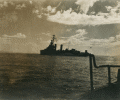
| 155k | "Dress Ship" as seen from the whaleboat, note the homeward bound pennant. From the collection of William J. Mosher located at the National Destroyermens Museum housed aboard the USS Joseph P. Kennedy, Jr. (DD-850). | Ed Zajkowski |

| 84k | December 3 1945, in dress blues ready for liberty, last day in full commission. From the collection of William J. Mosher located at the National Destroyermens Museum housed aboard the USS Joseph P. Kennedy, Jr. (DD-850). | Ed Zajkowski |

| 93k | December 3 1945, Commodore Brodie on foc'sle, last day in full commission. From the collection of William J. Mosher located at the National Destroyermens Museum housed aboard the USS Joseph P. Kennedy, Jr. (DD-850). | Ed Zajkowski |
Memorabilia
|

| 56k | Historical data plaque for USS Wilkes. This plaque is on display as part of the "Serving the Naval Fleet" exhibit in the Charlestown Navy Yard Visitor Center of Boston National Historical Park. (Stephen P. Carlson photo) | Stephen P. Carlson, Boston NHP, Charlestown Navy Yard |

